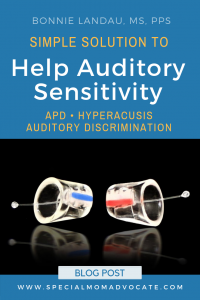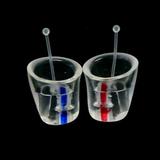 Many people with APD (auditory processing disorder) suffer from hyperacusis (sensitivity to sound) and difficulty understanding in noisy situations (auditory figure-ground issues). For child this is especially difficult because school is filled with all sorts of loud noises as well as noisy environments.
Many people with APD (auditory processing disorder) suffer from hyperacusis (sensitivity to sound) and difficulty understanding in noisy situations (auditory figure-ground issues). For child this is especially difficult because school is filled with all sorts of loud noises as well as noisy environments.
What is hyperacusis?
With hyperacusis, the sensitivity to sounds could be specific sounds or being in situations where noise is prevalent. In school, some kids have reactions when the bell rings, when a child shrieks or if there is a sudden, crashing sound. Other kids may not do well in any situation where there is a lot of noise. This could include the playground at recess, parties in the classroom or music class.
When a child has hyperacusis, their behavior will be impacted. They often become irritable or angry in noisy situations. Some kids who are sensitive to sudden loud noises will run off or hit whoever is near then when the noise happens. Oftentimes hyperacusis is the result of excessive ear infections in childhood. Sometimes it can be helped as the child gets older, or by listening therapies. Magnesium has also been shown to calm the auditory system, thus reducing the sound sensitivity.
What are auditory figure-ground issues?
When we are in a noisy environment, your brain can usually push the noisy elements to the background and focus on what is being said. People with auditory figure-ground challenges cannot do this. Their brain cannot differentiate between background noise and foreground noise, and so all sounds have the same volume.
This makes it very difficult to understand conversations, and so extra effort has to be made to try and understand. This extra effort is exhausting and makes noisy environments a challenge.
Solution: Musician’s Ear Filters
 My older son had auditory processing disorder before he did neurofeedback. He had hyperacusis and severe auditory figure-ground challenges. In school when a loud noise would happen, he would often hit whoever was near him. In the classroom, when kids talked or shuffled papers, it made it impossible for him to focus. As the school day progressed, he became more and more irritable as he struggled to do his schoolwork.
My older son had auditory processing disorder before he did neurofeedback. He had hyperacusis and severe auditory figure-ground challenges. In school when a loud noise would happen, he would often hit whoever was near him. In the classroom, when kids talked or shuffled papers, it made it impossible for him to focus. As the school day progressed, he became more and more irritable as he struggled to do his schoolwork.
Then I found a simple solution: Earasers. They are musician’s ear filters that were originally made for musicians to use during practice and performances. These ear filters have the ability to filter out the loud noises but let in the moderate noises. This means for the musician the loud sound of the instruments is muted, but he can still hear his bandmates sing. Earasers use a patented technology that filters the noise, thus reducing hearing damage for musicians.
 The best thing is, Earasers are amazing for kids with auditory sensitivity. They help mute the disturbing sounds while still allowing the child to hear people talk. They are very easy to put in and take out, and they are barely noticeable.
The best thing is, Earasers are amazing for kids with auditory sensitivity. They help mute the disturbing sounds while still allowing the child to hear people talk. They are very easy to put in and take out, and they are barely noticeable.
There are more expensive filters that you can get from an audiologist, but that can cost upwards of $3,000. Earasers cost around $38, and it is a simple fix to a complex problem. Also, if you are considering getting custom ear filters, trying Erasers first will help you decide if this approach may help.
Where can you buy Earasers?
You can get them on Amazon.com or music retailers like Guitar Center. The company will help you choose the right size, and they have a 30-day money back guarantee if you do not feel like they help.
ABOUT THE AUTHOR:
Bonnie Landau is a professional counseling and holistic therapist in Ventura County, California. Her specialities include therapy for autism, therapy for ADHD, and therapy for parenting who have kids with autism or ADHD or other neurodivergence. She changed careers from graphic design to counseling with the goal of helping struggling parents of kids with ADHD, autism, or other neurodivergence find strategies and solutions to help their children succeed. Bonnie is also the author of Special Ed Mom Survival Guide: How to Prevail in the Special Education Process and Find Life-long Strategies for You and Your Child.


